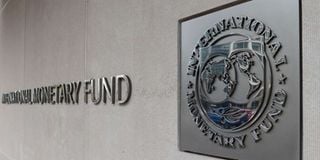
An exterior of the International Monetary Fund Headquarters in Washington, DC in this file photo taken on March 27, 2020.
What you need to know:
- IMF mission announced on November 20 that they had ironed out most conditions for providing the programme save for addressing weakness in State-owned companies and budget cuts.
Previously Kenya had kept away from direct budget funding from institutions such as the IMF and the World Bank during retired President Kibaki’s regime with most of the support coming in the form of project support.
After a long time, the executive board of the International Monetary Fund (IMF) will in February next year in Washington DC, be deliberating on a most important decision for the affairs of Kenya.
Whether to grant the country $2.3 billion (Sh250.4 billion).
Their decision will largely focus on three things, chopping of Kenya’s supplementary budget, elimination of Covid-19 tax cuts and how East Africa’s biggest economy will have navigated debt restructuring under the G20 debt relief terms.
Right across Washington, the World Bank will be watching this meeting upon which it will base its decision on the fate of Kenya’s application for $1.5 billion (Sh150 billion).
Outside, like a pack of wolves and vultures, Eurobond holders, syndicated lenders, ratings agency and currency speculators will have an eye on IMF and the market to decide whether Kenya will get the programme and be considered safe or denied and be damned as high risk, punished with high borrowing costs and weak shilling.
IMF mission announced on November 20 that they had ironed out most conditions for providing the programme save for addressing weakness in State-owned companies and budget cuts.
Policy objectives
“There is broad agreement on the policy objectives that would underpin a fund-supported programme. Remaining issues to firm up include the scope of SOE weaknesses and plans to revise the budget for FY2020/21,” IMF said last month.
Kenya borrowed Sh75 billion from the World Bank last year and a further Sh100 billion this year. Treasury also borrowed Sh79.3 billion from the IMF.
A source in banking with links to top Kenyan creditors said Kenya has to reduce the gap between planned spending and expected revenues to qualify for additional funds under the IMF programme.
“IMF executive board meeting in February will be looking at the size of debt obligation that is why they want Kenya to take the G20 debt relief. What we have been told by Eurobond holders is that they are ok with Kenya pursuing the relief so long as they are not included in the restructuring or Kenya does not go for debt cancellation,” a banking executive told Smart Business. Central Bank Governor, Dr Patrick Njoroge, said Kenya will make a decision to fulfil IMF conditions based on what is good for the country playing down the urgency for the programme.
“There are ongoing discussions, which will be completed according to our need assessment of what is good for us,” Dr Njoroge said during a post monetary policy press briefing last week.
Previously Kenya had kept away from direct budget funding from institutions such as the IMF and the World Bank during retired President Kibaki’s regime with most of the support coming in the form of project support.
Kibaki took over from the late president Moi when Kenya’s public debt stood at Sh629 million at 60 percent of GDP and grew the economy over the next decade with minimal loans. By the time he left in March 2013 he had doubled Kenya’s debt to Sh1.79 trillion but with an expanded economy to support it putting debt at 41 percent of GDP.
Enter President Uhuru Kenyatta’s Jubilee administration which has gone on to borrow at least Sh6.1 trillion to implement his manifesto in 10 years in power but struggled to grow the economy putting debt currently at 69.2 percent of GDP.
Coronavirus pandemic
Now with the coronavirus pandemic, the country’s deteriorating cash-flow situation that is marked by falling revenues and worsening debt service obligations has forced Kenya to return to the IMF and World Bank loans, which have tough strings attached.
The biggest challenge for the current administration is culling their addiction to huge budgets that they can barely fund.
The full-year budget deficit forecast for this fiscal year has been increased to 8.9 percent (Sh1 trillion) of gross domestic product from 7.5 percent (Sh841.06 billion) in June.
Treasury needs to cut spending in the mini-budget something that rarely happens in a pre-election year where government spends more to provide cheap unga and subsidised electricity to voters while lining politicians’ pockets with tender money to fund the oncoming elections.
Getting the IMF programme may come with painful austerity measures in the middle of the coronavirus pandemic, but it is almost a necessity.
Over the last few years Kenya has fallen back on loans to bridge the spending gap and refinance maturing debt making it unsustainable at Sh7.0 trillion in August or 69.2 percent of GDP.
dguguyu@ke.nationmedia.com





No comments :
Post a Comment